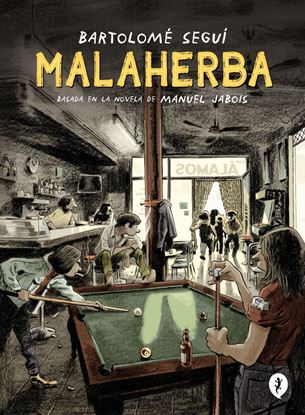

MALAHERBA (NOVELA GRAFICA)
La primera vez que papá murió todos pensamos que estaba fingiendo». Así comienza el extraordinario debut literario de Manuel Jabois, una historia que ahora, gracias a la genial adaptación gráfica de Bartolomé Seguí, podemos revisitar bajo una mirada nueva, con unos personajes que traspasan la página y un final que se quedará con el lector para siempre.
Malaherba cuenta la historia de Tambu, quien, junto a su mejor amigo Elvis, Claudia y su hermana Rebe, atraviesa los últimos días de niñez, esos en los pasan cosas a las que todavía no se sabe poner nombre. Por el camino descubrirá las muchas caras del amor y la muerte, y que, a menudo uno comprende lo que siente cuando ya es demasiado tarde.
1,400
1,050
VICTOIRE
Maryse Condé, autora de Yo, Tituba, la bruja negra de Salem y de La Deseada, regresa a su isla natal de Guadalupe y a sus raíces en Victoire. La madre de mi madre, para narrarnos la fascinante vida de su abuela materna, Victoire Élodie Quidal, una cocinera que se convirtió en una figura legendaria de su época. Victoire, cuya piel era de una «blancura australiana» y cuya destreza culinaria fue codiciada por la élite, pasaba la mayor parte del tiempo encerrada en el templo de su cocina, que era como la propia Guadalupe: un crisol heterogéneo de razas y culturas en el que convivía la población negra, la mulata y los blanc pays que ejercían el poder en el archipiélago antillano. En este complejo cosmos dominado por la hegemonía francesa, una cocinera criolla que apenas podía pronunciar el nombre de sus platos en francés consiguió convertirse en una de las personalidades más importantes de la isla guiándose siempre por la profunda convicción que dirigía su existencia: ninguna labor es humilde si se aspira a la perfección.
Condé rastrea sus orígenes en una historia que fusiona con una sensibilidad exquisita memoria e imaginación. Tras sumergirse en su árbol genealógico, nos ofrece una de las historias más emotivas y cautivadoras de su trayectoria. Un testamento único y desgarrador de la vida en Guadalupe en el crepúsculo del siglo XIX.
1,400
1,050
EL CAFE DE LA LUNA LLENA
En Japón, los gatos son símbolo de buena suerte y dicen que, si eres amable con ellos, algún día te devolverán el favor. Pero resulta que si, además, te portas bien con el felino adecuado, puede que este te invite a entrar a una cafetería que no es como las demás, ya que no tiene una ubicación ni un horario fijo y se muestra solo a las personas que se encuentran en un momento crucial.
Mientras los clientes de El Café de la Luna Llena disfrutan de sus deliciosos dulces, cafés y tés, un gato muy carismático lee su carta astral para así hacerles ver en qué punto han tomado el rumbo equivocado y devolverlos al camino que las estrellas tienen reservado para ellos.
1,400
1,050
EL HOMBRE DE CRISTAL
La inspectora Leonore Asker, al mando de la peculiar Unidad de Casos Perdidos, recibe una llamada del todo inesperada: su padre, con quien no tiene contacto desde hace más de quince años, necesita su ayuda, ya que se ha hallado un cuerpo en su finca y la policía sospecha que él ha sido el asesino.
Mientras, Martin Hill se muda a una finca apartada para escribir una biografía sobre el empresario Gunnar Irving, intrigado por el hecho de que la legendaria propiedad contiene una isla privada con un observatorio astronómico abandonado. Pronto, Hill descubre que la zona tiene más historias que ofrecer: luces misteriosas y cuerpos mutilados. Mientras Asker y Hill intentan encontrar respuestas, un temible asesino en serie, el hombre de cristal, surge de las profundidades de la oscuridad de las que nadie regresa jamás.
1,400
1,050
CANON DE CAMARA OSCURA
Vidal Escabia, el protagonista de esta historia, ha seleccionado setenta y un libros en un cuarto oscuro de su casa con la idea de escribir un canon desplazado, intempestivo e inactual, disidente de los oficiales. Cada mañana, elige al azar uno de ellos, y saca a la luz un fragmento con destino al Canon, pero lo que desentraña su lectura influye en su vida y también en su escritura.
Las sospechas crecen en torno a si el narrador de Canon de cámara oscura es un androide, un Denver-7 infiltrado entre la gente corriente de Barcelona o si, por el contrario, utiliza el Canon para dar sentido a su vida ante el amor desorbitado que siente por su hija ausente.
Un Vila-Matas extremo que va más allá en su indagación sobre el sinsentido, el simulacro y la ficción como extrañas formas de vida, y también en su visión del arte literario como transmisión, colaboración y modificación de ideas ajenas. Una búsqueda, en definitiva, de un sentido último de la escritura, al tiempo que explora temas como el doble o la ausencia infinita que dejan aquellos a los que amamos, «la misma ausencia que Eurídice le dejó a Orfeo y de la que muchos creen que nació la escritura».
1,400
1,050
LA MUY CATASTROFICA VISITA AL ZOO
Es víspera de Navidad y la visita de la clase de Joséphine al zoo ha sido una catástrofe. Nadie sabe qué ha pasado exactamente y los padres de la niña están dispuestos a descubrirlo. Mientras la investigación avanza, comprendemos poco a poco que una catástrofe nunca llega sola, que las apariencias engañan y que los acontecimientos pueden tomar un giro que nadie imagina.
La muy catastrófica visita al zoo nos mantiene en vilo hasta el final; es una novela divertida y emocionante, repleta de guiños sobre nuestra sociedad, sobre la democracia, la educación inclusiva, el rol de los padres y de los maestros.
1,400
1,050














